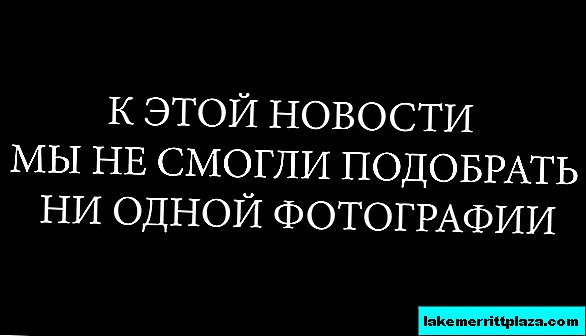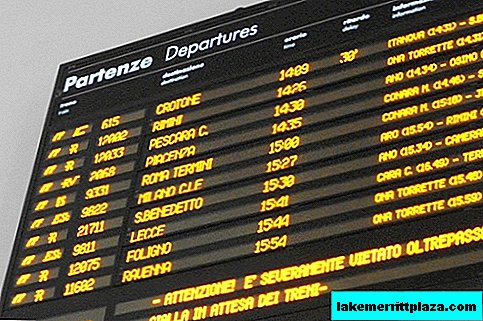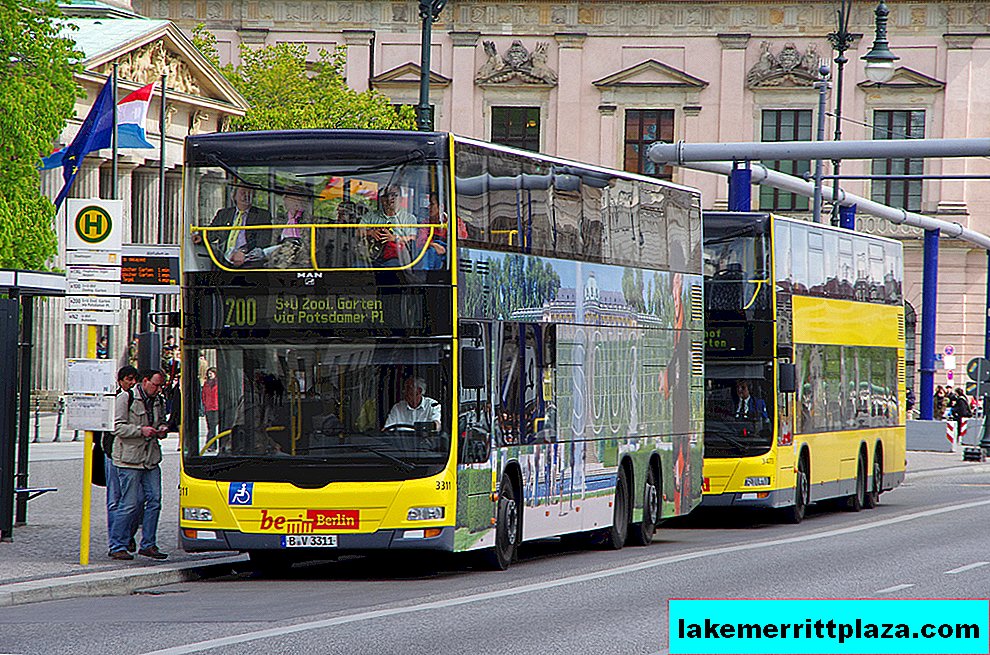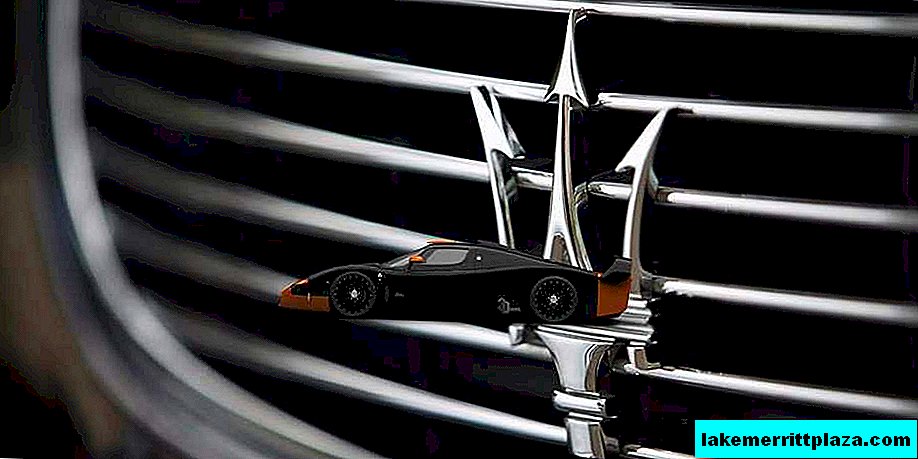The name of the outstanding Italian scientist Galileo Galilei (Galileo Galilei) is well known even to people who are far from physics, mathematics and astronomy. His fundamental works and inventions had a significant impact on the development of scientific thought of the XVI - XVII centuries and subsequent eras.
Biography
Galileo Galilei was a staunch rationalist who believed that all the phenomena and laws of nature have their own explanations and are subject to the human mind. He went through a bright, interesting and in many ways difficult life journey, leaving a deep mark not only in Italian, but also in world history.
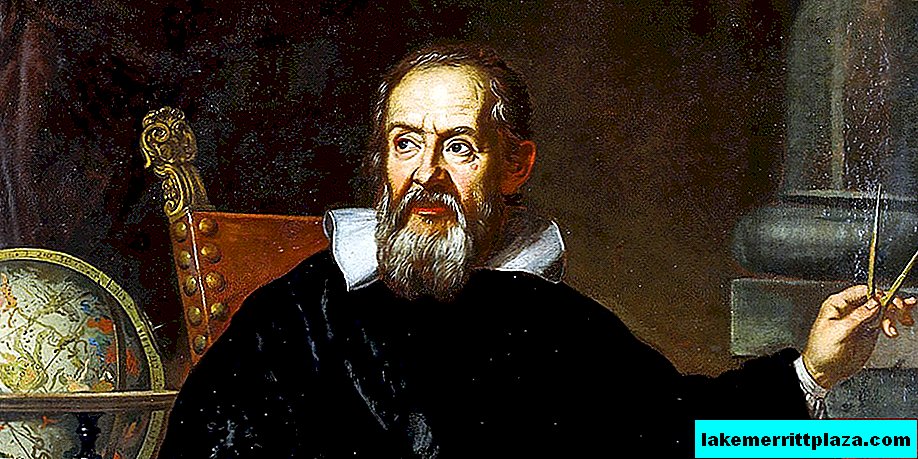
Family and background
The hometown of Galileo Galilee was Pisa. The future scientist was born in 1564, in the family of an impoverished nobleman, musician and composer Vincenzo Galilei, a highly enlightened and educated person, forced to engage in petty trade due to a deplorable material condition.
Galileo's mother, Giulia Ammannati, also belonged to a noble family, was distinguished by her heavy, wayward character, and devoted her life to raising children and housekeeping. It is known that among the descendants of the aristocratic family (along the father's side) there were scientists and doctors, and references to some of them who held important government posts in the Florentine Republic (Repubblica fiorentina) are found in documents dating back to the XIV century.
Galileo was the eldest of six children (two died in infancy). When he was about 11 years old in search of a better life, the family moved to Florence (Firenze), which at that time was the center of culture, science and art throughout Europe.
- I advise you to read: how to get from Pisa to Florence
Elementary education
Young Galileo grew up as a comprehensively gifted child who showed a talent for music and fine art. He managed to carry his love for creativity throughout his life, having achieved considerable success in this area.
Primary education was obtained at the Abbazia di Vallombrosa Abbey School, located in the small commune of Reggello, in the province of Florence. Galileo was a diligent student: within the walls of the monastery he with the same zeal and zeal he studied theology, ancient languages, poetry and rhetoric, composed poems that were distinguished by special talent and expressiveness. The youth liked the life in the monastery, he became a novice, and dreamed of taking priestly dignity.
Student years
Galileo's idea of devoting himself to serving God was categorically rejected by his father, and in 1581, at the insistence of a parent who dreamed of a more profitable lesson for his offspring, he entered the University of Pisa (Universita di Pisa), at the Faculty of Medicine.
In parallel with the main course, a young student enthusiastically studied mathematics, geometry, physics and astronomy. The young man immersed himself in theory and incessantly set up scientific experiments. Very quickly, he decided on the business of his life, and moved from the medical faculty to the mathematical one. As a student, Galileo discovered the heliocentric theory of Copernicus, becoming its zealous adherent.
At the university, he gained fame not only as a young man striving for knowledge, but also an avid debater who did not know the art of diplomacy, and who always had his own opinion, and did not consider it necessary to hide it. Due to the financial difficulties of the family, the training could not be completed in full, having completed only three courses. The intemperance and wayward character of the young man (inherited, most likely, from his mother) played a cruel joke with him. Despite the giftedness of the student, the teaching staff refused the opportunity to continue their studies for free. Having not received a professor’s degree, Galileo returned to Florence.
The patronage of Guidobaldo del Monte
Fortunately, the young man’s talent for technical sciences and outstanding inventive abilities were noticed by Guidobaldo del Monte, a renowned mathematician, mechanical theorist, astronomer and philosopher who was respected and respected by his contemporaries.
The role of this man, who had a lot of money and a position in society, turned out to be extremely significant in the fate of Galileo. Guidobaldo del Monte became the patron of a young scientist, he made every effort to present the young talent to the Grand Duke of Tuscany, Ferdinando I Medici, and procured for him a paid position as a professor of mathematics.
So, already in 1589, at the age of 25, Galileo returned to the walls of alma mater, and began teaching. At the University of Pisa, he lectured in mechanics and mathematics, set up experiments, conducted ongoing research, and wrote treatises. Unfortunately, his enthusiasm for technical sciences did not bring Galileo a lot of money, because the modest salary he received was ten times different from the income of a professor of medicine.
It is noteworthy that material difficulties haunted the scientist throughout his life. In 1591, the head of the family died, and the responsibilities for the maintenance of the mother and two sisters fell on Galileo's shoulders.
Work at the University of Padua
In 1592, Galileo, who had already earned a certain authority in the scientific community, and who had the glory of an outstanding theoretician and inventor among his contemporaries, moved to Padova, a large city in the Republic of Venice (Serenissima Repubblica di Venezia). There, for 8 years, he taught mathematics, mechanics, and astronomy. Galileo headed the department at the University of Padua (Universita degli Studi di Padova), considered the oldest and best educational center in Europe, and this was the most fruitful period of his scientific career.
The personal life of a scientist
The main and only true passion of the scientist was science, although biographers know for sure about the story of Galileo's love for a woman who gave him two daughters and a son. A native of Venice, Marina Gamba (Marina di Andrea Gamba), belonged to a poor family, and had a lower social status. An official church marriage with her was never concluded, even despite the presence of three common children. It is also known that the couple lived together during the period when Galileo worked in Padua.
Leaving the city, the professor took his daughters, and after some time his younger offspring. The scientist officially recognized only his son (paternity was confirmed by him in 1619), his daughters were considered illegitimate, and spent his life in a monastery at the church of St. Matthew in Arcetri (Chiesa di San Matteo in Arcetri), a small village near Florence. Having been born out of wedlock, in those days they did not have the slightest chance of a happy marriage. Galileo retained his connection with children throughout his life.
Life and work in Florence, relations with the Catholic Church
Glory did not save Galileo from the constant need for money. In 1610, in the hope of improving his financial condition, the scientist gladly accepted the invitation to move to Florence, where he lived until 1632. Highly paid work as an adviser and teacher at the court of the Duke of Tuscany, Cosimo II de 'Medici, promised to get rid of accumulated debts. At the same time, he officially retained the post of professor at the University of Pisa, which does not require burdensome duties of lecturing.
As the "first mathematician and philosopher" at the court of the Duke, Galileo actively continued his astronomical research. He widely promoted the heliocentric system of the world, collected scientific evidence, thereby causing irritation and discontent among many representatives of the church and followers of the teachings put forward by Aristotle and Ptolemy. By this period, Galileo, longing to comprehend the secrets of celestial bodies, had already managed to make a number of revolutionary discoveries, which included:
- The presence of spots on the sun;
- The rotation of the Sun around its own axis;
- The rotation of the Earth not only around its own axis, but also around the Sun;
- The presence of irregularities (mountains and craters) on the surface of the moon;
- Detection of the moons of Jupiter;
- The discovery of the rings of Saturn;
- Observation of the phases of Venus;
- An explanation of the nature of the Milky Way, consisting of countless stars.
In 1611, the scientist came to Rome to receive Pope Paul V in order to prove to the head of the Catholic Church the need to keep pace with scientific thought. He demonstrated the telescope he made, explained the essence of his discoveries, and was generally welcomed with warmth and favor. It is noteworthy that despite subsequent conflicts with the church, Galileo always considered himself a "good Catholic".
Accusations of heresy
Since 1611, a series of events took place that significantly influenced the fate of Galileo. At first, encouraged by the kind disposition of the higher clergy, he wrote (and later recklessly published) a letter to his student and friend Benedetto Castelli, in which he openly declared that the Holy Scriptures are good only for faith and repentance, and cannot serve science as an authoritative source of knowledge about objects and phenomena of nature.
Then, in 1613, Galileo's book On Sunspots, the essence of which was the recognition of the correctness of the theories of Copernicus, was published. As a result, after two years, the Inquisitors opened the first case against the scientist. The trial of Galileo took place in Rome, 1616, during the same period the church officially recognized heliocentrism as a dangerous heresy, and although the scientist was acquitted, he was ordered to abandon open support for the Copernican world model and trampling archaic authorities.
In 1633, the second trial of the scientist took place. The reason for the repeated persecution of the Inquisition was the publication of Galileo's next treatise, "Dialogue on the Two Systems of the World," written in Italian for accessibility to a wide range of readers.
After the first interrogation, Galileo was taken into custody; he spent 18 days in prison. Many biographers tend to suggest that the scientist was even brutally tortured. He was convicted of heresy, and sentenced to life imprisonment (later changed to house arrest), the inquisitors also demanded that Galileo renounce all his beliefs (which he did) and forbade the publication of any theoretical and research work.
The legendary phrase, "Eppur si muove" ("Still, it revolves"), attributed to the scientist, actually never belonged to him, and is nothing more than an artistic fiction.
The last years of life, death and post-mortem rehabilitation
The scientist was seriously ill in old age, and in 1637 Galileo completely lost his sight. He could not publish his works, but did not cease to engage in science, even despite worsened health. Inquisitors constantly monitored the prisoner until the end of his days, making communication with friends and students difficult.
He spent the rest of his life in a small villa located in Arcetri, a suburb of Florence, not far from the monastery where his daughters served. The building has survived to this day and is now the house-museum of Galilee (Villa Il Gioiello)owned by the Faculty of Astronomy of the University of Florence since 1942 (Universita degli Studi di Firenze, UNIFI).
In 1642, the great scientist died at the age of 78, surrounded by his followers and son. The church banned the burial of a heretic in the family crypt and the erection of monuments to him. The last representative of the famous family, the grandson of Galileo, took monastic tonsure, and burned the valuable manuscripts of his grandfather. In 1737, the remains of a scientist were reburied in the Basilica di Santa Croce in Florence.
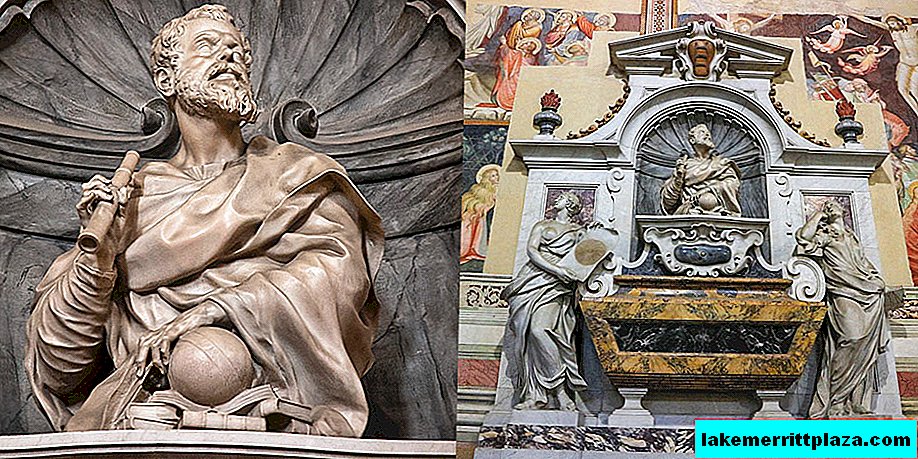
The tomb is decorated with a marble figure of Galileo and allegorical statues in the late Baroque style, representing Geometry and Astronomy. The decoration of the sarcophagus was carried out by Italian sculptor Giovanni Battista Foggini.
Only in the second half of the 20th century did the Catholic Church acquit Galileo by removing all charges from him, in 1992, according to the results of the work of the special commission, Pope John Paul II officially recognized the mistake of the Inquisition.
Scientist discoveries
Galileo is rightly considered the founder of exact science. His inquiring mind made it possible to discover and formulate the laws of nature on which physics as a science in general and mechanics in particular, in their current understanding, are based. Galileo introduced new research methods based not on ephemeral reasoning and references to authoritative dogmas, but on observations, experiments, and mathematical analysis. The discoveries that have fundamentally changed the scientific worldview include:
- The law of isochronism (period of oscillation of the pendulum);
- The law of free fall of bodies;
- The principle of motion of bodies on an inclined plane;
- Law of addition of movements;
- Principle of relativity;
- The law of inertia.
The scientist also made a significant contribution to the development of the mathematical theory of probability and sets. He conducted research on the nature of light, measured the density of air, dealt with issues of physical optics. The main inventions of Galileo, which influenced many areas of human life, include:
- hydrostatic scales for determining the density of bodies;
- thermoscope - an analogue of a modern thermometer;
- telescope and the reverse version of the device - a microscope;
- proportional compass for zooming.
Galileo was engaged in invention from an early age to a very old age, he constantly came up with new instruments and devices.
Telescope making
The creation of the telescope is considered one of the main and significant inventions of Galileo, because the device gave a powerful impetus to the knowledge of the solar system.
The first copy was presented to the general public in 1609. As a basis for the invention, a scientist who previously worked on improving the technology of grinding optical lenses took the "telescope" invented by Johann (Hans) Lippersgeim, a spectacle master from Middelburg (Netherlands).
Galileo improved the Dutch optical device and gave it its current name, translated literally from the ancient Greek language “I look far”. The Italian professor managed, unlike his predecessor, to achieve thirty-fold increase in the image.
Using his instrument, he created detailed sketches of the lunar surface, discovered spots on the Sun, studied the nature of the Milky Way, made the assumption of the existence of other galaxies and made a number of other revolutionary discoveries described in the treatise "Starry Herald", published in 1610. The book became a real sensation in Europe, the fame of it reached even China. It is noteworthy that Galileo created about a hundred telescopes in his life, he presented copies of the invention to representatives of the higher clergy and royal people, even tried to establish industrial production, but did not want to share the secret of lenses with fellow astronomers.
Interesting Facts
- Although Galileo was the first to formulate the laws of universal acceleration, there is no evidence that he ever dropped balls from the Leaning Tower of Pisa to prove them.
- When Galileo thought he had discovered several Saturns, he hid his finds by encoding them in an anagram.
- He sketched the ideas of various inventions, including a combination of candles and mirrors to reflect light through a building, an automatic tomato picker, a pocket comb that doubled as tableware and a ballpoint pen.
- After his father died and, fearing the debtor’s prison, made a living by designing a military compass for aiming cannonballs. His earlier invention, the first thermometer to measure temperature fluctuations, failed.
- For a short period of time worked as an art teacher in Florence
- In 1610, Galileo was the first astronomer to discover the four moons of Jupiter - these cosmic bodies were called the "Galilean moons" in his honor. The four moons associated with the Galilee are Io, Europe, Ganymede and Callisto. The largest of the Galilee Moons is Ganymede. Thus, he discovered the first satellites ever known in the orbit of a planet other than Earth.
- 400 years later, the Galileo telescope is still preserved and available at the Institute and Museum of the History of Science (Istituto e Museo di Storia della Scienza) in Florence at Piazza dei Giudici, 1, 50122 Firenze. The museum has two telescopes and lenses that were built by Galileo himself. Official site: www.museogalileo.it
- I could not publish my book while I was under house arrest. However, it was published in Holland in 1638.
- It is said that Galileo was blind because he had observed the Sun for a long time while he was looking at the sunspots with his telescope.
- It was depicted on an Italian denomination of 2,000 lire.
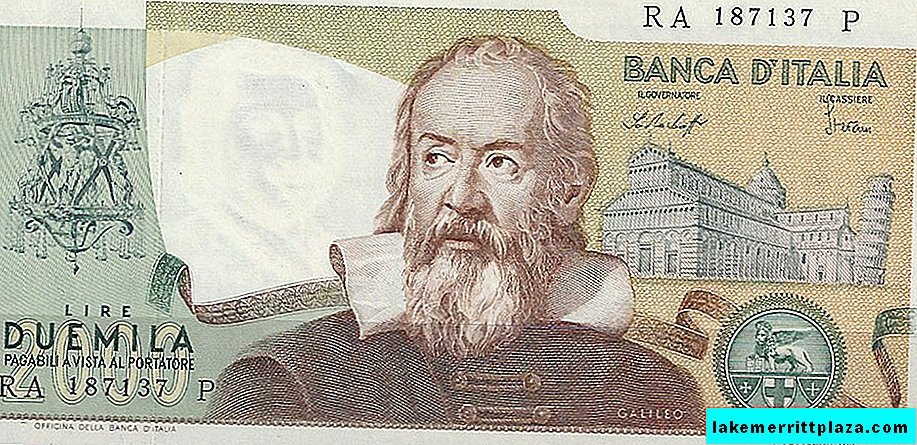
- Pisa International Airport (Aeroporto Internazionale di Pisa, di Aeroporto Galileo Galilei, IATA code: PSA) is named after the Italian scientist, it is located 5 kilometers from the city center.
- Found that in the absence of air resistance, gravity accelerates all objects equally, regardless of their mass.
- Galileo was opposed to Kepler’s theory that the Moon causes tides on Earth, and instead believed that this was due to the rotation of the Earth. Surprisingly, Kepler supported Galileo for his work by publishing letters in his support at that time.
- Initially, the Galileo telescope could magnify the image only eight times. However, he soon perfected it to provide a twenty-fold increase.


